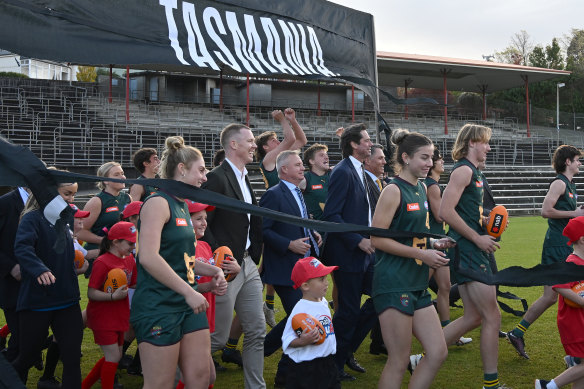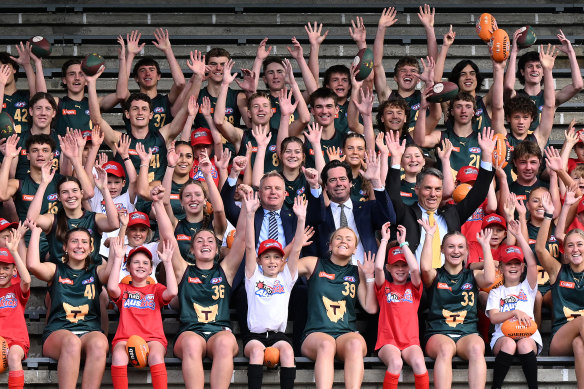By Peter Ryan
Tasmania’s AFL club will come to life on Monday night with the unveiling of a traditional bottle-green jumper with a yellow map of the state on the front.
The club, almost certain to be called the Devils, will start signing up members at $10 a pop.
Official launches will be held at six Tasmanian sites, and streamed to clubs and pubs across the Apple Isle, in an attempt to unite the state behind the team ahead of Saturday’s state election in which the proposal for a new $715 million stadium is a key issue.

Then AFL CEO Gillon McLachlan, Tasmanian Premier Jeremy Rockliff, Deputy Prime Minister Richard Marles and former Richmond star Jack Riewoldt at the announcement of the AFL’s 19th team in Tasmania last May.Credit: Getty Images
The club’s first chair, Grant O’Brien, will join football legend Matthew Richardson in Devonport to broadcast to the world what colours Tasmania will wear when they join the AFL in 2028.
“[The launch] is for the team and for the club, but it is actually for the state,” said O’Brien, who will make the announcement from a site about 20 minutes from where he played in Penguin’s 1980 premiership team.
“Our first tangible elements will be there for people to attach themselves to.
“Up until this point in time, the most tangible thing people have had by way of a representation of the club has been a stadium visual on the front page of the paper.

The scenes at North Hobart Oval for the announcement of the Apple Isle’s own AFL club.Credit: Getty Images
“Most of the debate has been around that. We want to have an argument about whether we picked the right jumper.”
O’Brien would not be drawn on the stadium debate but AFL boss Andrew Dillon reiterated over the weekend that a new 23,000-seat, roofed stadium at Macquarie Point was essential and non-negotiable.
“The licence that’s been granted is conditional on a number of things which includes the stadium being built at Macquarie Point with a roof and with a capacity of at least 23,000,” Dillon told ABC Radio.
“What we’re excited about is the announcement on Monday night when the Tassie footy club will announce its nickname and its colours at seven events and a number of satellite events all around Tasmania, uniting all of Tasmania.”
A theme song will come later, as will the naming of the first CEO, likely to be Richmond’s current chief Brendon Gale, according to Caroline Wilson’s report on Footy Classified last week. Members can start signing up as foundation members from Monday night, with more than 40,000 supporters expected to pay the $10 membership fee between now and October 31.
The state Liberal Party, led by Jeremy Rockliff, says the stadium plan will go ahead, albeit with the government capping its expenditure on the stadium at $375 million, with the federal government to contribute $240 million, and the AFL $15 million plus private investment.
The ALP, led by Rebecca White, says it wants Tasmania to have a team in the AFL, but the club needs to prove itself worthy of a new stadium first before they will commit to funding the infrastructure.
“You prove up the team. You prove it works. You demonstrate you’ve got the crowd numbers,” White, who wants to renegotiate the AFL deal, said.
“If we need to invest in infrastructure to support the capacity that we’re seeing turning out every day, then maybe we make a decision collectively that we do it then.″
A bunch of independents – many likely to be elected to the 35-seat chamber under the newly adopted Hare-Clark electoral system – are potentially crucial to where the decision lands if they are required for one of the parties to form government.
The AFL’s constant position has been that a new stadium would provide the capacity, the environment and the potential for commercial returns the club would need to be competitive in the AFL, which is why the new licence is tied to it being built.
Tasmania Football Club says the AFL has lent support since awarding the licence in May last year.
AFL TAS chief executive officer Damian Gill stepped out of his office to allow Tasmania’s executive director, Kathryn McCann, and the club’s first employee, the respected Lizzie Dingeldei – referred to internally as their number one recruit – a place to achieve what O’Brien says are 45 tasks on the club’s to-do list this year.
“They are allowing us to build this club the way we want to build it and the way it suits Tasmanians to build it,” O’Brien said.
“The way we are building this club and thinking about it is based on community. It is not about having an elite bunch of players and us worshipping them, it is creating an environment that sparks engagement and participation.”
He returns to the reason he first became involved in the taskforce years ago; that an AFL team was essential to revitalise grassroots football in the state after years of neglect by the AFL, which has promised $358 million to support the team and game development in Tasmania.
“This is an opportunity to revitalise the ecosystem in football,” O’Brien said.
Like a thrilling goal that gets the crowd on its feet before being sent for a score review, Monday night’s announcement will spark a wave of emotion that is quickly tempered as attention turns to the election.
Keep up to date with the best AFL coverage in the country. Sign up for the Real Footy newsletter.